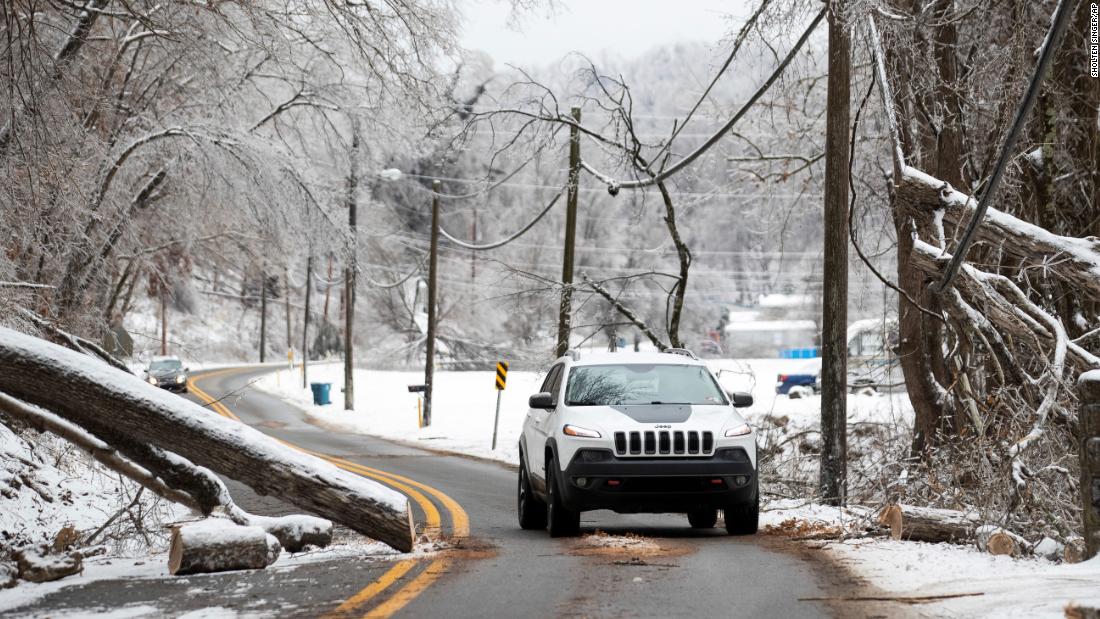
More than 100 million people stretching from Texas to Massachusetts are under a winter storm warning or winter weather advisory, and more days of freezing could mean multiplying the harrowing stories of hardship.
The blistering cold weather that has brought blankets of snow and widespread power outages to Texas and Oklahoma is expected to move east on Thursday, bringing half an inch of ice to parts of North Carolina and Virginia, according to CNN meteorologist Taylor Ward.
A tornado watch is in effect for parts of the Florida Panhandle, Southwest Georgia, and Southeast Alabama until 8 a.m. EST. Washington, DC will be covered in snow, sleet and freezing rain Thursday morning, while New York should see six to eight inches of snow in the afternoon, Ward said.
The weather is not the typical winter cold. Some of those already hit by the storm have spent days without power and water and are not likely to see temperatures rise above freezing until next week.
Texans have borne the brunt of the need.
A mother told CNN that she is considering driving to Mexico to protect her family at a hotel. With another freeze expected, she is out of options for three of her children whose insulin goes bad and her child with the autism spectrum who has a compromised immune system.
“You either go to the shelter to get warm, or you stay at home, stay cold and stay away from the pandemic,” Sylvia Cerda Salinas told CNN’s Don Lemon.
The weather turns fatal
Continued severe weather means more days at risk of death and injury.
The U.S. Centers for Disease Control and Prevention (CDC) warned doctors on Wednesday to be aware of the increased risk of carbon monoxide poisoning and deaths as storms sweep across the country.
Carbon monoxide is a tasteless, odorless gas that can build up when any type of fossil fuel is burned – gasoline, coal or natural gas. Home heating systems are a common source, but the danger is especially high when people turn to unusual heat or power sources during a power outage.
From Saturday to Monday, four adults in Oregon died from carbon monoxide poisoning while trying to keep warm, the Clackamas County Sheriff’s Office said. One person appears to have lit charcoal briquettes inside, while three others took shelter in recreational vehicles.
While Kentucky officials have responded to calls regarding carbon monoxide, state police reported on Wednesday that a 25-year-old was found dead on Friday from hypothermia.
Texas has lost 16 residents to weather, with the rest of the toll spread across Tennessee, Oregon, Kentucky, North Carolina, Louisiana, Ohio, Oklahoma, and Arkansas.
Residents take refuge in their car
With little else available, many families rely on their vehicles to get through the cold.
Another Texan family, faced with a home with no electricity, chose to drive more than 200 miles through snow and ice for shelter.
The normally two and a half hour ride turned into a five or six hour trek, Bryce Smith said. He said all that made the drive from Austin to Royce City possible was that he is from Iowa and knows how to drive in the snow.
‘There are no teams here. There is no help at all. When you get out here it’s just fresh snow and ice. There is no sand in it, ”he said.
Long wait for power to return
Winter storms in Kentucky have “physically damaged the infrastructure that transmits and supplies electricity to households,” and some residents still lack power by the week’s end, state officials said.
“We think we will make significant progress towards the end of this week in getting people back to power, but in some parts of eastern Kentucky it may take longer than the end of the week,” said Governor Andy Beshear. , who recognized that the news was difficult for residents.
The weather has also turned off aquatic plants in many places, including Marlin, a town in central Texas with a population of over 5,500.
Speaking of residents’ frustration, Marlin City Manager Cedric Davis said, “They scold us, cry us out, say they don’t understand, they don’t understand. We cried last night. We give everything. People are so inhumane. “They don’t understand. I’ve never seen anything like it,” the Waco Tribune-Herald reported.
Fortunately, the Texas electricity provider, the Electric Reliability Council of Texas (ERCOT), said it was making progress on Wednesday in restoring power to the state’s electrical system and hoped local utilities would return to rotary outages Thursday morning instead of prolonged outages. failure.
CNN’s Melissa Alonso, Konstantin Toropin, Dave Alsup, Artemis Moshtaghian, Rebekah Riess, Jason Hanna, Steve Almasy, Ed Lavandera, Joe Sutton and Keith Allen contributed to this report.